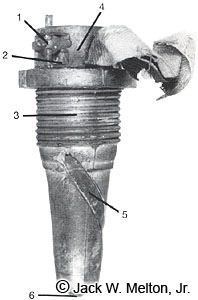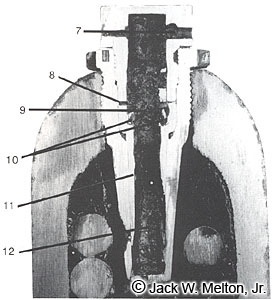Schenkl Combination Fuze

Complete Schenkl
Combination fuze

Cross-section of the
Schenkl Combination fuze
Schenkl Combination Fuze
|
|
|
|
| This fuze stock (3) is made of zinc and has a time index (2) on the face of the top flange graduated from zero to 9 1/2 seconds. The fuze body is closed at the bottom (6) and pierced by a series of small holes (5) spiraling down from the middle of the fuze body to the end. The rest of the fuze consisted of a combustible fuze compound (12) contained in a metal case which also had holes spiraling down but in an opposite direction from the body. A rotator (4) is screwed into the top of the fuze. Inside the rotator is the plunger, which is held in place by a soft metal pin and an iron safety pin. An interior fuze rotator (11), affixed to the top rotator by two metal dowels, contains a fulminate ring (10) and a highly combustible soluble cotton compound (9). When the artillerist was ready to arm the fuze, he removed the safety pin (placed where #7 points; pin is missing from this cutaway) and lifted the spring clip (1), set the rotator to the correct time (using a stamped arrow as a guide), and then locked the rotator in place. By doing this the two sets of holes lined up with each other to produce the proper burning time. The inertia of the cannon firing caused the safety pin (placed where #8 points; pin is missing from this cutaway) to break and threw the plunger back against the ring. The flame from that action caused the cotton to flare up and light the time fuze compound. The flame burned through the two holes into the projectile's powder chamber. If the projectile struck anything before the time fuze was through burning, the fuze body would break, causing the burning compound to drop immediately into the powder chamber. | |